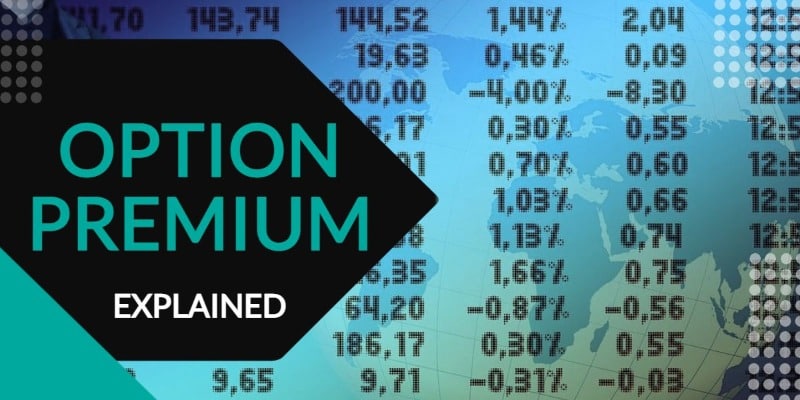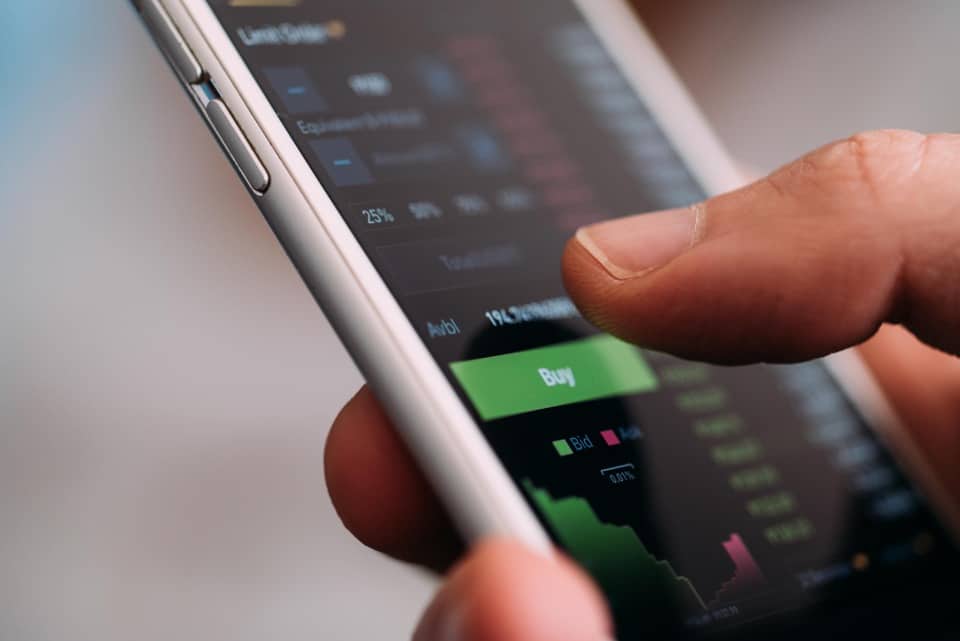Option Premium Explained
What is the option premium?
The option premium is the price you pay for the right to buy or sell an underlying asset at a predetermined price (the strike price) in the future (at the expiry date). An option contract is a contract that guarantees such rights. The option seller receives a fee, the option premium, in exchange. There’s no obligation for the buyer to exercise the option at the expiration date. The option premium is also known as the option price.
What is the cost of the option premium?
There are several factors that contribute to the premium of a single option contract.
So what do you pay for the premium of an option? Well, it’s the price for that option set by the market. The option premium is not a fixed amount, but changes as the price of the underlying changes. It’s, in fact, the derivative of the option price with respect to the underlying. Option premiums typically consist of intrinsic and extrinsic value. In-the-money options will have both intrinsic and extrinsic value, whereas out-of-the-money options contain only extrinsic value, which is to a large extend time value. Another factor impacting an option’s premium is volatility — which for you to keep in mind means that higher implied volatility increases the cost of purchasing a contract.
The option premium can increase or decrease depending on the price of the underlying security, its volatility, the amount of time remaining until the expiration date, and the current interest rate of the market.
It’s important to understand how each of these factors contributes to the final price. The primary contributors are the current price of the stock or underlying, the strike price, and the time until expiration. Other things to consider are commissions, exercise fees, and the bid-ask spread. The bid-ask spread is the price difference between the lowest price someone is willing to sell at and the highest price someone is willing to buy at.
What factors influence the option premium?
There are many factors that contribute to the price of an option contract and its changing value over time:
- The price of the underlying security: That’s easy. The more valuable the underlying security, the higher the price of the option. That’s also called the intrinsic value.
- The time to expiration: The shorter the time to expiration, the higher the price of the option. The reason is that the “time decay” effect of an option with a short time to expiration becomes more pronounced as the option nears its expiration date. So, if you want to pay less for an option, pick one with a longer time to expiration.
- The volatility of the underlying security: The implied volatility is very important for options pricing. The more volatile the security, the higher the price of the corresponding option. Volatility is one measure of risk. Riskier securities demand a higher price in the marketplace than less risky securities.
- The dividend rates: Dividends have a profound effect on the premium. The reason is that, most often, a stock has a “dividend discount.” That means that, when you buy a stock, you actually receive less than 100% of the declared dividends. It is horrible for the options traders. Why? Because the increase in the share price causes the intrinsic value of the option (the part that is not based on the share price) to go up too. This means that, whenever a special dividend is paid, the price of the corresponding call or put option will rise. Sometimes, this effect can be dramatic.
- The interest rate: When the rate changes, so does the price of the underlying asset. Therefore, a change in the rate will cause your stock price to fluctuate which will impact the value of your option position too.

How is the option premium calculated?
Calculating the premium or price of an option is quite complex. The reason is that a non-trivial and non-linear mathematical formula determines the current value at each time. Therefore, it is best to let a program do it for you.
So how are option premiums determined? The closest way to show the market price of an option is through the famous formula below. This formula is known as the Black-Scholes model, and it is a widely used model for pricing financial options.

Option premium formula
The formula takes into account the following information:
S = stock price
X = strike price
r = annual rate of interest
σ = standard deviation
n = time to exercise
The most famous formula is based on the Black Scholes model:
| CALL OPTION PROFIT = S – X * ( 1 + r * t) ^ (-1/2. * σ * exp(-r * t) |
The Black Scholes formula is based on the idea of a “Brownian Motion” process. A Brownian Motion is a very random walk like process. If you think about it, it makes sense. After all, what could be more random than a bunch of electrons bumping around inside an atom? The electrons are sort of like the stock price of a company. In other words, the BM model is based on the idea that stock prices move randomly up or down, independent of any factor which may be under your control.
So, in essence, the BM model says that a company’s stock price will move up or down by an amount equal to its “Normal Deviation” multiplied by the “Standard Deviation” of the process and times the “Speed” with which the electrons are moving around inside the atom. The faster they are moving, the further they will travel from where you are standing. As I said, this formula is based on the idea of a Brownian Motion process. Understanding the Black Scholes model is crucial.
In reality, stock prices do not move in a completely random fashion. There are many, many factors which influence the price of a company’s stock. However, for the most part, the influence of these factors is much more predictable than the unpredictable influences which create a “Black Swan” event. One of the predictable influences on the stock price of a company is the “P/E Ratio”. This is the price per share which would be required to buy the stock if you were to sell out all your shares today and go on to another investment.
Stocks with the highest option premiums
When an option has a high premium, it has high price relative to how far the stock price is from the strike price. Stocks with higher option premiums are often considered risky, because if the underlying asset price doesn’t increase above the strike price, the option will expire worthless. On the other hand, the larger the difference between the strike price and the underlying price, the more valuable the options are. If the strike price is far away from the current price, the options are worth more.
Examples of stocks with the historically highest option premiums:
- Tech, telecommunication, oil exploration, real estate, gambling: These are the very stock markets that have seen the highest premiums in the market for options. One of the best stocks to benefit from high options premiums is Apple Inc. It has a history of high premiums that even its downward trend a few years ago did not destroy. What is more, Apple Inc. has a very volatile stock price, so the premiums are really high.
- Micro and small cap stocks: Furthermore, considerably high options premiums are achieved in micro-cap stocks and small cap stocks. You can find this information by simply logging into the options section on financial sites like Yahoo Finance.
How to determine if the option premium is too high or fair
Let’s recap what we’ve learned so far: The option premium is mainly determined by four factors: volatility, time till expiration, interest rate and the asset’s price.
- Call option premiums are higher if the stock price is high, the stock price is volatile, the interest rate is high and if the time till expiry is low.
- Put option premiums are higher if the stock price is low, the stock price is volatile, the interest rate is high and if the time till expiry is less.
Generally, call option premium will be higher than put option premium.
Before you buy an option, you must estimate the fair value of the option. Rules of thumb may not be sufficient. To determine whether the option premium is too high, look at the underlying’s market price: For example, this could be the value of a stock, not the option. Option volatility: The more volatile the stock price, the more volatile the option price. Dividend yield: The higher the dividend yield, the more valuable the option. Time to expiration: For a longer-term option, the stock price has to move farther for the option to make or lose money.
There are three methods you can use to determine the fairness of the option premium:
The first is to compare it to the other options on the same exchange. The other is to look at the historical record of the option. And the third one is the discounted cash-flow method.
Compare different option premiums on the same exchange: Use the Black-Scholes Model to determine the fair price of stocks or index options. This will give you an idea of what the premium should be. Compare the other options on the same exchange. If you find the premium to be significantly higher than what is fair, you may want to stay away from the options. If the premium is much lower than what’s fair, you should consider the option to be a bargain. One of the most useful things in this regard is the option delta. The option delta tells the investor how much the option value will change when the underlying price changes by $1. There are certain standard option premiums for different option deltas. If the option premium is higher than the standard option premium, then it can be said that the premium price is too high .
Check the historical record of the option premium: You want to see what prices the option has traded at in the past. If it has regularly traded above what the Black-Scholes fair value says it should be, then this is a sign that the options are overpriced. If the option has regularly traded below what the Black-Scholes fair value says it should be, then this is a sign that the option is underpriced.
Use the discounted cash-flow method: In this case, the fair value of an options contract is the discounted present value of its expected future cash flows. Understanding option premium and its changes over time requires a strong knowledge of the underlying asset and the factors affecting its valuation. Determining the expected future cash flows and discounting them to their present value can be very difficult and, therefore, subjective. However, many tools are now available to estimate fair value.
How do option premium charts look like?
Option premium charts are graphical representations that illustrate the relationship between the price of an option and its intrinsic value.
An option premium chart is an index-type chart, with each line corresponding to a different strike price for a specific contract expiration date. The lines on these charts are color-coded and show what price you would get if you bought a call or put option at that strike price.
Where can I find historical option premiums?
Option trading is a risky business but has a risk-to-reward ratio that can be the most rewarding. If you are an investor and want to trade options, it is important to learn how to manage your risks. One way to do this is by using historical option premium prices. Historical option premiums tell you what the price of an option was in the past and help you see what type of return it gave users in the past when they were trading them at those prices.
Historical prices can be found online and there are many websites that offer this information. Some of the more popular sites are yahoo finance and IVolatility.

Frequent Questions
How do demand and supply affect the premium?
Demand and supply affect the options premium. As demand for a particular stock grows, the demand for an option on that particular stock also increases. This increase in demand usually leads to an increase in the market price of the option.
As stocks become more expensive, investors are willing to pay more to buy call options on those stocks. The opposite can be observed when there is a decrease in demand for a particular stock or when that stock becomes less expensive.
This is because as an option becomes more expensive, it provides greater leverage and capital protection than if it were cheaper.
Can the premium of stock options be negative?
A common misconception is that a stock option can have a negative price. This is not the case because options have only two states- In-The-Money and Out-Of-Money (when it is has no intrinsic value anymore).
When does extra risk strictly increase an option’s value?
The extra risk for an option will always increase the value of that option. Additional risk is what makes an option more valuable, it is not the opposite.
This means that while the downside may be higher, there is also a greater potential reward. The additional risk you are taking by choosing this option might be offset by the larger upside that you get in return.
When we think about options in finance, we need to make sure that we understand some of the key concepts so we can understand their value. One of these concepts is called “extra risk.” This is when there are two different opportunities with different risks and rewards involved, but both have the same cost to buy or sell.
Where is the break-even point?
The break even point is the point on the option’s time line where the cost of a call option is equal to its intrinsic value.
Options traders usually look for options with a high break-even point because they would be more profitable if their speculation proves correct. A trader can find an option premium price and break-even point by looking at historical prices for similar options that have already expired.
Why does volatility influence the market price of an option so much?
Volatility is a measure of “risk”. That means that with higher volatility, the market expects a higher likelihood that the underlying asset price will change very dramatically over a certain period of time. For example, consider a stock which has a volatility of 20%. This means that, on average, the price of this stock will change by 20% every month. That’s why the implied volatility needs to be a core metric for pricing options. Else traders would simply buy the options with the highest volatility in the underlying security to maximize their expected returns.
How should traders adjust their positions to take advantage of changes in the premium?
Traders should focus on the intrinsic value and especially the implied volatility of the company and not on its stock price. A low-priced stock may be worth more than a higher priced one if it has a higher potential for growth in the future.
Some authors propose the following rule: If a trader’s exposure to the stock is small, then the trader should adjust his position as little as possible. But if a trader’s exposure to the stock is large, then he should adjust his position aggressively in the face of news.
This rule helps traders avoid an unnecessary adjustment of their positions. The authors also found that when adjusting by size, traders who are more exposed to the stock tend to be more aggressive in altering their positions.
What’s the relationship between the premium and the Greeks?
As we have discussed, the options premium is the price an investor pays for an option. The Greeks refer to the various values used by traders to calculate an option’s value.
The relationship between the premium and the Greeks is that with changes in volatility, time remaining until expiration, or stock price, the extrinsic component of an option’s premium will change accordingly, with the same sensitivity.
Who determines the premium of option contracts?
As you know, an option contract is a type of financial instrument that allows the buyer to purchase or sell an underlying asset at a predetermined price.
Option contracts are usually traded on an exchange and they are always traded with a broker. The seller of the contract is called the writer, and they set themselves apart by being obligated to fulfill the terms of the contract if it is not offset prior to expiration date.
How are option premiums taxed?
Taxation of options is an area of confusion for many people. Taxes on options are calculated at the time that the option is exercised and typically result in a capital gain or loss that will be reflected on your taxes.
Option premiums are taxed when they are exercised, not when they were originally purchased. When it comes to a capital gain or loss, this will be reflected at tax time.
When is the option premium paid?
The option premium is always settled at expiration but you need to have the cost for options in your trading account before purchasing options. The seller will be credited once the option has expired. However, if you sell an option before expiration, you will have to pay a “time value” of the premium. This means you will have to pay a higher price for the option than if you had allowed it to expire and then exercised your option.
We call the option premium a deferred option premium, when it isn’t paid until the expiration of the option. A deferred premium option is an interesting financing tool for the seller of an option. The buyer pays for it up-front, but the seller collects on it at a later date.
What are the different types of options premiums?
There are two basic types of option premiums. They are:
Type A – A Call Type Premium: A call type premium is the amount you pay to purchase a call option.
Type B – A Put Type Premium: A put type premium is the amount you pay to purchase a put option.
The main differences between these two types of option premiums is: The premium you pay for a call option is always less than (and usually much less) than the premium you pay for a put option. Why? Because, you can always make a profit by selling calls (buying them from someone else) rather than buying puts (selling them to someone else).
Also, you receive the maximum profit amount when you sell calls (buy puts) just before the stock price reaches your strike price. However, this does not mean you should only use call options in your option trading. Puts can be a better choice when the underlying asset is very likely to move up or down a great deal in price or you want to hedge your position.
If you are new to option trading, I suggest you start with call options because they are easier to understand regarding general concepts like “at-the-money” and thus easier to use for investors. Plus, you will be well on your way to mastering all aspects of option trading if you do not fully understand and are comfortable with the basics of call options.
When is it appropriate to use call and put options?
The appropriate time to use these types of options depends on your opinion about where an asset’s underlying stock will be in the future. If you believe it will rise, you might want to purchase call options because they’ll increase in value as well. On the other hand, if you believe it’ll fall, put options might be your best bet.
Stocks Options Premium vs Fx Options Premium
The difference between stock options premiums and fx options premiums can mainly be found in the underlying securities. They are both financial derivatives of different underlyings. While pricing of stock options is based on stock markets, pricing of fx options is based on currency pairs.
But the general concepts are the same. Both stock options and forex options give the buyer the right to buy an underlying at a given price before a given date. And both carry with them a time value and an intrinsic value and are highly affected by changes in the implied volatility.
History of the option premium
Option premiums have a long history, dating back to 1887 when they were first used as financial instruments by Hermann Schlesinger. Initially, they were created for the purpose of protecting against future price fluctuations in stocks and commodities.
In 1973, Robert C. Merton and Fischer Black introduced the idea of the modern option premiums which we use today in their paper, “Theory of rational option pricing.” Prior to this paper, it was not possible to compute the intrinsic value of an option without knowing how it will behave over time.

Key Takeaways
Option premium is the price of an option contract. The option premium is what you pay for the right to buy or sell a stock at a specific price in the future.
- The price of the premium is based on several factors, including the risk associated with the option, the time until expiration, and the stock price. The option’s premium is also based on volatility.
- Options with a greater degree of volatility are usually more expensive than those with a lower degree of volatility.
- Option premiums are calculated with option pricing models such as the Black-Scholes model.
- There are two types of options, call options for long and put options for short.